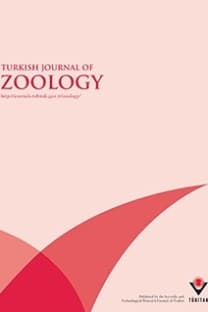Predation of a scorpion (Scorpiones: Buthidae) by an assassin bug(Heteroptera: Reduviidae) in the Brazilian Atlantic Forest
Predation of a scorpion (Scorpiones: Buthidae) by an assassin bug(Heteroptera: Reduviidae) in the Brazilian Atlantic Forest
___
- Albuquerque CMR, Porto TJ, Amorim, MLP, Santana Neto PL (2009). Scorpionism caused by Tityus pusillus Pocock, 1893 (Scorpiones; Buthidae) in State of Pernambuco. Rev Soc Bra Med Trop 42: 206208.
- Ambrose DP (1999). Assassin Bugs. Enfield, NH, USA: Science Publishers.
- Barth R (1952). Die Fangdrusen an den Beinen von Zelus (Diplocodus) leucogrammus (Perty). Zool Jahrb 73: 323336 (in Geman).
- Cloudsley-Thompson JL (1960). Notes on Arachnida, 35 - A scorpion eaten by a beetle. Entomol Mon Mag 95: 223.
- Cloudsley-Thompson JL (1977). Adaptational biology of Solifugae (Solpugida). Bull Br Arachnol Soc 4: 6171.
- Cogni R, Freitas AVL, Amaral Filho BF (2002). Influence of prey size on predation success by Zelus longipes L. (Het., Reduviidae). J Appl Entomol 126: 7478.
- Cohen AC (1995). Extra-oral digestion in predaceous terrestrial arthropoda. Annu Rev Entomol 40: 85103.
- Evangelin G, Horne B, Muthupandi M, John WS (2014). Venomous saliva of non-haematophagous reduviid bugs (Heteroptera: Reduviidae): A review. Biolife 2: 615626.
- Horn S, Hanula JL (2002). Life history and habitat associations of the Broad Wood Cockroach, Parcoblatta lata (Blattaria: Blattellidae), and other native cockroaches in the coastal plain of South Carolina. Ann Entomol Soc Am 95: 665671.
- Hwang WS, Weirauch C (2012). Evolutionary history of assassin bugs (Insecta: Hemiptera: Reduviidae): insights from divergence dating and ancestral state reconstruction. PLoS One 7: e45523.
- ICMBio (2015). Instituto Chico Mendes de Conservação da Biodiversidade. Available from: http://www.icmbio.gov.br/portal (Accessed 21 March 2015).
- Lira AFA, Albuquerque CMR (2014). Diversity of scorpions (Chelicerata: Arachnida) in the Atlantic Forest in Pernambuco, northeastern Brazil. Check List 10: 13311335.
- Lira AFA, Costa AA (2014). First record of a brown widow spider Latrodectus geometricus Koch, 1841 (Araneae, Theridiidae) feeding scorpion (Scorpiones, Bothriuridae) in a Brazilian Atlantic Forest. Braz J Biol 74: 1011.
- Lira AFA, DeSouza AM (2014). Microhabitat use by scorpion species (Arachnida: Scorpiones) in the montane Atlantic Rain Forest, Brazil. Rev Ibér Aracnol 24: 107108.
- Lira AFA, Rego FNAA, Albuquerque CMR (2015). How important are environmental factors for the population structure of co-occurring scorpion species in a tropical forest? Can J Zool 93: 1519.
- Lira AFA, Souza AM, Silva Filho AAC, Albuquerque CMR (2013). Spatio-temporal microhabitat use by two co-occurring species of scorpions in Atlantic rainforest in Brazil. Zoology 116: 182185.
- Lisboa EBF, Moura GJB, Melo IVC, Andrade EVE, Figuerêdo Júnior JM (2011). Aspectos ecológicos de Hypsiboas semilineatus(Spix, 1824) (Amphibia, Anura, Hylidae) em fragmento de Mata Atlântica, nordeste do Brasil. RICA 2: 2130 (article in Portuguese with an abstract in English).
- Lourenço WR (2002). Scorpions of Brazil. Paris, France: Les Éditions de lIf.
- McCormick SJ, Polis GA (1990). Prey, predators, and parasites. In: Polis GA, editor. The Biology of Scorpions. Stanford, CA, USA: Stanford University Press, pp. 294320.
- Melic A (2000). El género Latrodectus Walckenaer, 1805 en la peninsula Ibérica (Araneae: Theridiidae). Rev Ibér Aracnol 1: 1330 (article in Spanish with an abstract in English).
- Moreno-González JA, Hazzi NA (2012). Intraguild predation case: Tityus forcipula Gervais, 1843 (Scorpiones, Buthidae) feeding on Chactas vanbenedeni Gervais, 1843 (Scorpiones, Chactidae) in Colombia. Rev Ibér Aracnol 20: 117120.
- Polis GA (1990). The Biology of Scorpions. Stanford, CA, USA: Stanford University Press.
- Polis GA, Sissom WD, McCormick SJ (1981). Predators of scorpions: field data and a review. J Arid Environ 4: 309326.
- Porto TJ, Brazil TK, Lira da Silva RM (2010). Scorpions, state of Bahia, northeastern Brazil. Check List 6: 292297.
- Punzo F (1998). The Biology of Camel Spiders (Arachnida, Solifugae). Boston, MA, USA: Kluwer Academic Publisher.Stevenson DJ, Greer G, Elliott MJ (2012). The distribution and habitat of Centruroides hentzi (Banks) (Scorpiones, Buthidae) in Georgia. Southeast Nat 11: 589598.
- Stevenson DJ, Stohlgren KM (2015). Predation on the scorpion Centruroides hentzi (Banks) (Scorpiones: Buthidae) by the assassin bug Microtomus purcis (Drury) (Insecta: Hemiptera: Reduviidae). Southeast Nat 14: N1N4.
- Weirauch C (2006). Observations on the sticky trap predator Zelus luridus Stal (Heteroptera: Reduviidae: Harpactorinae), with the description of a novel gland associated with the female genitalia. Denisia 50: 11691180.
- Williams SC (1966). Burrowing habitat of the scorpion Anuroctonus phaeodactylus (Wood) (Scorpionida: Vaejovidae). Proc Calif Acad Sci 34: 419428.
- Zhang G, Weirauch C (2013) Sticky predators: a comparative study of sticky glands in harpactorine assassin bugs (Insecta: Hemiptera: Reduviidae). Acta Zool 94: 110.
- ISSN: 1300-0179
- Yayın Aralığı: 6
- Yayıncı: TÜBİTAK
Tarik DANIŞMAN, KÜBRA CEREN KARANFİL, İlhan COŞAR
A new species of Athripsodes from the southwest of the Iberian Peninsula (Trichoptera, Leptoceridae)
Luis MARTÍN, A. Marcos GONZALEZ, Jesus MARTINEZ
Halil İbrahim YOLCU, Aziz ASLAN, Halil SARIBAŞAK, Hasan UYSAL, Abdurrahman ÇOBANOĞLU, Ayhan SERTTAŞ
Rafet ASLANTAŞ, Göksel TOZLU, Alper ORHAN, Banu Şebnem ÖNDER
Elena ANUFRIIEVA, Nickolai SHADRIN
Seyyed Saeed Hosseinian YOUSEFKHANI, Sahar Javaheri TEHRANI, Behnoush MOODI, Serkan GÜL
S. Stefanos ANDREADIS, I. Emmanouel NAVROZIDIS, Stylianos KATERINIS
Senhao JIANG, Xuehong TONG, Jun CUI, Baoming GE, Daizhen ZHANG, Boping TANG, Chunlin ZHOU
A new species of Coelotes Blackwall, 1841 (Araneae: Agelenidae) from Turkey
